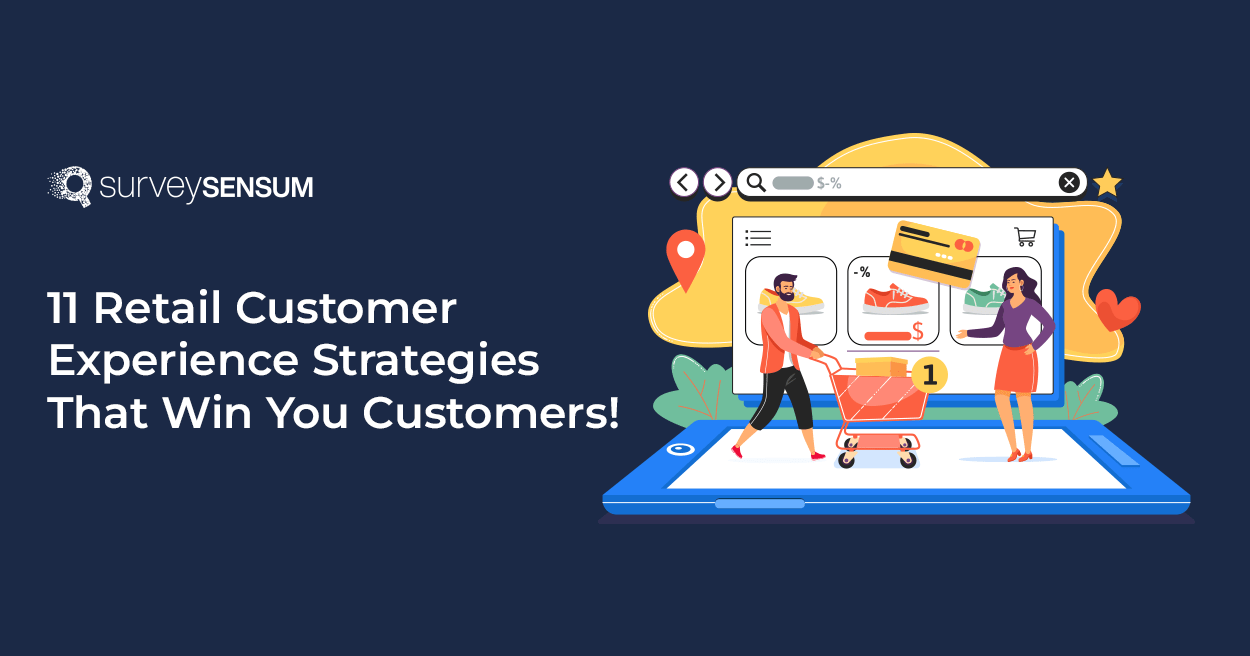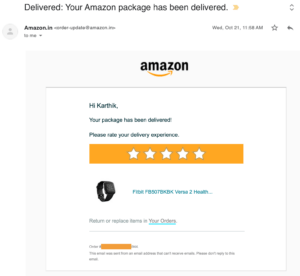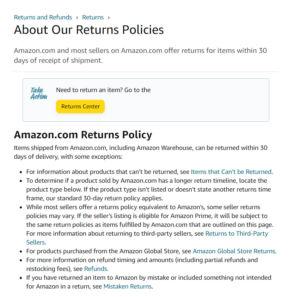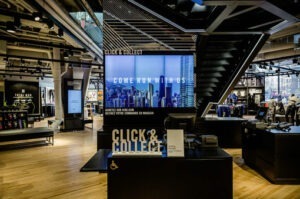
Do you have a favorite brand that you love to shop from even if you have absolutely no shopping requirements but go there just for the experience?
Because I do and that brand for me is IKEA.
Honestly, I go to IKEA whenever I feel bored and have nothing else to do. Why?
Because I love shopping there!
Even if I have absolutely nothing to buy. I love to browse through the different sections, experience new products, sometimes buy items on display and of course, eat their famous meatballs.
Creating a memorable retail shopping experience, both online and in-store, is like taking your customers on an amazing trip so that even after the trip is over they always come back for more.
But how to do that?
By implementing powerful retail customer experience strategies that brands like Amazon, Decathlon, IKEA, etc. have adopted,
So, what are these top winning retail customer experience strategies? And how can you incorporate them?
Let’s talk about each retail customer experience strategy, in detail, by exploring some of the best customer experience stories of the retail industry.
- Make Shopping Easy & Fun
- Make Every Interaction Epic!
- Ensure A Seamless Transition From Online to Offline & Vic-Versa
- No Holdup At Checkout Please!
- Keep Your Inventory Stocked
- Don’t Forget The Post-Purchase Interaction
- Bring People Together Like A Community
- Happy Employees = Satisfied Customers
- Keep Up With the Changing Customer Expectations
- Create A Multichannel Buying Experience
- Make Your Membership Program Meaningful
11 Retail Customer Experience Strategies
Let’s have a glance at each strategy.
1. Make Shopping Easy & Fun
In today’s competitive retail landscape, providing customers with an enjoyable and hassle-free shopping experience is crucial to winning their loyalty. This involves creating a seamless and user-friendly interface for both online and physical stores, as well as incorporating interactive elements that enhance the overall experience, and reduce cart abandoment rates.
Decathlon, a renowned sporting goods retailer, excels in this retail customer experience strategy. They offer an innovative shopping experience by providing in-store test zones where customers can try out sports equipment for different types of triathlons before making a purchase.
This creates an interactive experience that allows the customers to experience the product, test it out and be 100% satisfied with it before purchasing. Customers can play cricket inside their stores, ride cycles, and test out outdoor tents, and other tactical gear before purchasing.

By adopting similar strategies, retailers can create an environment that encourages customers to explore, engage, and enjoy their shopping journey. This ultimately leads to increased customer satisfaction and loyalty, resulting in a competitive edge in the retail industry.
2. Make Every Interaction Epic!
Let me give you a picture of an ideal customer journey.
Imagine – You enter a retail clothing store to buy custom t-shirts. The store entrance is aesthetically pleasing and when you enter the store, the staff greets you warmly. The store layout is so perfectly designed that you didn’t have to ask for directions. You went straight to the t-shirt section and were pleased with their collection. You found a few good ones to buy, added them to your cart, and headed to the checkout area. In the checkout area, you saw a self-checkout booth so you did your own checkout. The payment was also smooth. You packed everything and exited the store satisfied with the experience. The same goes for the brand’s online store.
Sounds too good to be true? Well, yes because brands don’t pay attention to all the important touchpoints in a customer’s journey.
Every interaction your customer has with your brand, both online and offline, provides opportunities for you to ensure a positive experience.
But how to implement it?
- Actively gather feedback from your customers at each interaction. For example, gather post-purchase feedback via email or Whatsapp surveys and ask them about their experience with you. This includes product review, checkout process, delivery experience, etc.
- Now, that you have the data, analyze it. Understand the repeated pattern, negative feedback, and areas of improvement by using an efficient retail customer feedback tool.
- Take immediate action to resolve the issue. Communicate the action taken to your customers and close the feedback loop.
3. Ensure A Seamless Transition From Online to Offline & Vic-Versa
In 2020, Amazon launched its Amazon Fresh stores in the USA. This store uses new-age technology to create a seamless shopping experience between the physical store and the customer’s Amazon account.
This store features Amazon Dast Cart Lane. It is one of the best retail customer experience strategies because you’ve to simply enter the store, take the cart out, and put your items into it. The cart has a scanner that will be scanning your items and add them to your Amazon account. Once done, simply pack everything and exit the store. The total amount will be added to your Amazon account where you can pay via Amazon Pay. Cool, right?!
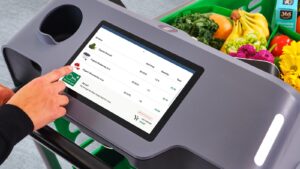
Customers want a shopping experience that caters to their convenience. For them shopping is shopping, no matter the medium.
Here are a few action points for you to implement a seamless shopping experience for your customers:
- Leverage customer data to build a transparent and seamless cross-channel shopping experience for your customers.
- Track customer feedback in real-time and take immediate action to resolve issues.
- Allow customers to interact with your brand where, when, and how they want.
- Harness the power of AI, VR, and AR to give your customers exceptional experiences like self-checkout, fast issues resolution using AI chatbots, and many more.
4. No Holdup At Checkout Please!
Who loves waiting in long queues to pay for a simple milk carton?
No one!
Long lines, faulty payment gateway, and no proper order at the checkout process are a horror for anyone. Even when shopping online crashing of the payment page, no confirmation on the order, and no proper communication on delivery is a nightmare.
Optimizing your checkout process is a crucial retail customer experience strategy. According to a report by the Baymard Institute on “Cart Abandonment Stats 2023”, it was found that the average cart abandonment rate is 69.9%.
69% is a lot of customers. So, how to resolve this issue?
- Install self-checkout counters equipped with a “scan and pay” app for billing like Decathlon. These self-checkout counters are hassle-free and easy to use and ensure a smooth checkout process.
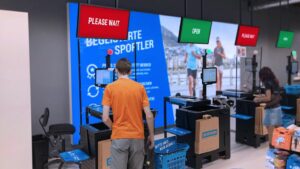
- Integrate contactless payment for quick transactions. You can see quick contactless payment via UPI and wifi enabled cards in many retail outlets and online stores. These payment methods ensure a quick, easy, and hassle-free checkout.
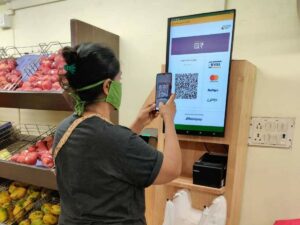
What is preventing your customers from coming back? – Find out with SurveySensum – Request a Demo
5. Keep Your Inventory Stocked
The worst feeling in the world, when it comes to shopping is that you find something you like, and it’s not available in your size or color. Frustrating, right?
Your customers also feel the same way when they find items not in stock and this factor might deter them from shopping with you in the future.
Addressing product availability is a key retail customer experience strategy. According to PwC, “Global Consumer Insights Pulse Survey” 42% of customers surveyed cited products being out of stock as their biggest point of frustration.
Keeping your inventory stocked will ensure that your customers have a prompt buying experience and exit your store happy and satisfied. And here’s how you can do that.
- Actively seek customer feedback through surveys to better understand which products customers desire and ensure that inventory aligns with customer preferences.
- Put the option of “Notify Me” when products go out of stock so that customers can click on it to notify you. Myntra has a similar option for their out-stock items.
- Actively monitor any alert on any product unavailability and take action to stock that item and notify the customer. This will ensure that your customers return back to your brand.
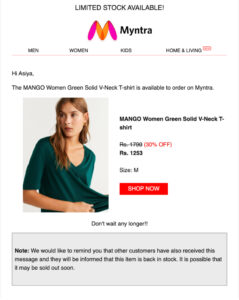
For instance, here’s how Myntra notified its customers regarding the availability of the product the customer was interested in. This way the customer got notified of the availability and might come back to shop from Myntra!
6. Don’t Forget The Post-Purchase Interaction
Once your customers have shopped with you does that end your interaction with them? No.
Once your customers have shopped with you it gives you an opportunity to assess their experience, understand their pain points, help them with refund, support, or maintenance, and take action on any negative feedback.
This is also the time when you nurture a long-lasting relationship with your customers and convert them into loyal customers.
Here’s how Amazon is leading in this retail CX strategy.
-
-
- Post-Purchase Feedback: Amazon sends out product confirmation emails and product tracking emails so that customers get notified when their order is placed and are also aware of when the package will arrive. Not only that, they also utilize pulse survey tools to send small feedback surveys post-delivery to gather feedback on the delivery experience.

- Easy Returns: Amazon also has a superb return policy. They offer 15-30 days return and replacement policy for most of their products. The process is also very swift. Just click on “Return” in your order section and the product will be picked from you.

- Customer Support: Now this is where Amazon shines. It provides multichannel support via chatbots on Amazon accounts for quick resolution and telephonic conversation with representatives.
7. Bring People Together Like A Community
Ever wondered why beauty brands like Sephora and Glossier have such a huge and diverse customer base? It’s because instead of making their brand just a beauty brand they evolved themselves into a community.
Humans are made of emotions so when you involve your customers in your brand on a personal level and encourage them to engage with each other, you create a sense of community among them. This enables you to create a brand image that is rooted in emotions and bonds.
Nike also took this retail customer experience strategy seriously and created a community among sneakerheads and sports enthusiasts. Apart from their awesome shoes, they have successfully created a community for their members.
Their Nike Experiences are a collection of events organized across the globe that allow like-minded Nike members to get together and share their love for Nike. They have done collective running events, wellness camps, and many more events.
Nike also shares REAL stories of REAL people and community with all the members enabling them to feel like they belong to a community.

8. Happy Employees = Satisfied Customers
A popular brand that excels in this retail customer experience strategy is Zappos. We have all heard stories of Zappo’s awesome customer support team going above and beyond to deliver top-notch customer service to their customers.
There are many instances where they have perfected the art of customer service.
For example, Zappos helped a customer to help them find the nearest pizza places at midnight even if they don’t sell pizzas. They also delivered the shoes of a best man overnight and gave him a full refund and VIP account. Or how their longest customer service call was 10 hours long and it wasn’t about their product, the customer just wanted to talk to someone. And many more amazing stories.
Now pause and think.
Do you think these employees would have gone beyond their job role to deliver these kinds of exceptional services if they weren’t happy and satisfied with the company?
No, right?
In order to create a positive retail customer experience, you as a retail brand need to make sure that your employees are happy and they understand your vision and goals, especially your customer-facing staff because they are your first line of defense.
Measure your Employee’s Satisfaction with SurveySensum – Request a Demo
9. Keep Up With the Changing Customer Expectations
Do you know the Netflix of today looks a lot different than the Netflix of 1997 when it was founded? Reed Hastings and Marc Randolph, the founders of Netflix started Netflix by sending movies and TV series DVDs over mail.

In September 2002, according to the New York Times, Netflix sold around 190000 DVDs per day. Their venture was a huge success but do you think they stopped there? No, Netflix predicted that the world will soon replace DVDs with streaming videos so they changed their whole strategy.
The Netflix of today allows you to watch movies & TV series from anywhere you want, via any electronic device of your choice. Moreover, this serves as a prime example of a retail customer experience strategy. Netflix enhances your streaming journey by harnessing data analytics and algorithms to personalize your experience. This understanding of customer needs led to increased customer satisfaction, as subscribers were able to discover and enjoy content tailored to their interests.

Now, how to anticipate your customer expectations like a pro?
- Actively seek customer feedback at different touchpoints along the customer journey To gain a better understanding of your customers’ expectations, demands, and evolving shopping behavior.
- Use multiple channels for communication like online surveys, social media polls, email feedback forms, etc.
- Consider using feedback management tools like Text Analysis for collecting real-time customer feedback, identifying emerging complaints, and tracking customer sentiment.
- Based on the insights gained from customer feedback, develop an action plan to address the key areas of improvement.
10. Create A Multichannel Buying Experience
Your customer’s shopping habits and behavior are not the same anymore. It has gone through some changes and evolved and it is now heavily influenced by the digital age. Embracing a multichannel buying experience is a vital retail customer experience strategy.
According to the Salesforce article, “Stats About the Retail Customer Journey”, 87% of shoppers begin their shopping journey with an online search before visiting any retail outlets.
Customers now want access to a multichannel buying experience. Creating a seamless multichannel buying experience is not only recommended but also advised as a part of creating a great retail experience.
According to Statista, in 2020 multichannel online retailers generated more than $350 billion in sales.
So how to create a multichannel buying experience for your customers?
- Understand Customer Behavior: Gather feedback to gain insights into your customers’ preferences, behaviors, and expectations across different channels. This will help you to understand how they interact with your brand and make purchasing decisions.
- Develop a Unified Brand Experience: Your brand messaging, design, identity, and voice should be the same across all channels. This includes your website, mobile app, social media platforms, and physical stores. This will create a seamless experience and build brand recognition.
- Enable Channel Integration: Integrate your various sales channels, such as online, mobile, brick-and-mortar stores, and call centers, to create a seamless shopping experience for your customers.
- Seamlessly Sync Shopping Carts: Enable customers to start shopping on one channel and continue on another without losing their cart contents. Just like Amazon did with their Amazon Dast Cart Lane.
- Provide Cross-Channel Shopping Options: Offer customers the flexibility to research, browse, and purchase products through their preferred channels.
For example, Nike offers the “Buy Online, Pick Up In-Store” option. With this option, customers can order online and pick them up at a nearby store. This feature combines the convenience of online shopping with the immediacy of in-store fulfillment.

11. Make Your Membership Program Meaningful
In a survey conducted by Statista titled, “Average Loyalty Program Membership Among US Consumers”, it was found that in 2022 consumers belonged to 16.6 membership programs on average but actively used a little less than half of those.
But why is that?
- Lack of Value Proposition: Membership programs must offer tangible benefits and value to customers. Your membership program should be able to justify the cost or effort of joining and participating in the program.
- Overcomplicated programs: Suppose you decided to buy an online subscription for grocery delivery but the brand you chose had a very complicated process of signing up. So you naturally move on from the brand.
- Irrelevant Rewards: Rewards play a significant role in enticing customers to join a membership program. If the rewards offered are not relevant to customers’ preferences or needs, the program may fail to generate interest.
- Forgetting to listen to their customers: Brands implement membership programs but forget to gather customer feedback on their programs which deters them from making necessary adjustments.
Now, how to fix that?
Learn from the successful retail customer experience examples of Amazon, Sephora, The North Face, Starbucks, etc.
- Simplify the Program Structure: No one wants to join a complicated membership program because it seems fishy. So, streamline and simplify the program structure and make it easy for your customers to understand and navigate.
- Enhance Rewards and Benefits: No one wants to join a program to get a sloppy gift card that doesn’t even cover the cost of the lowest range products. So, evaluate the rewards and benefits offered within the program and ensure that they are aligned with customer preferences.
- Provide Personalized Experiences: Leverage customer data and insights to tailor recommendations, promotions, and communications to individual members. Ensure that your members feel a sense of exclusivity and personal attention.
- Actively Gather and Act on Feedback: Regularly collect feedback from members through surveys, focus groups, or feedback forms to understand their satisfaction levels and identify areas for improvement. Actively address any issues or concerns raised by members and make necessary adjustments.
Conclusion
So, to sum it all up, customer experience has become absolutely essential in the world of retail. It’s no longer something retailers can afford to overlook—it’s at the very core of their success.
Gather and use customer feedback at various touchpoints of your customer’s journey to gather insights into their needs, preferences, expectations, and shopping behavior. This data will help you in creating and improving retail customer experience strategies for your business.
Use can also use Surveysensum to:
- Launch CSAT, CSI, SSI surveys, and more
- Collect omnichannel feedback in real-time
- Identify touchpoints with the most friction with journey-based dashboards
- Identify top trends and sentiments from thousand of feedback text analysis in just a few minutes.
- Get instant detractor alerts on your CRM so you can close the loop in time.
Follow the 11 retail customer experience strategies explained above that have proved to be beneficial to many of our clients like, Lifestyle, PineLabs, Mercedes – Daimler, and many more!
-






